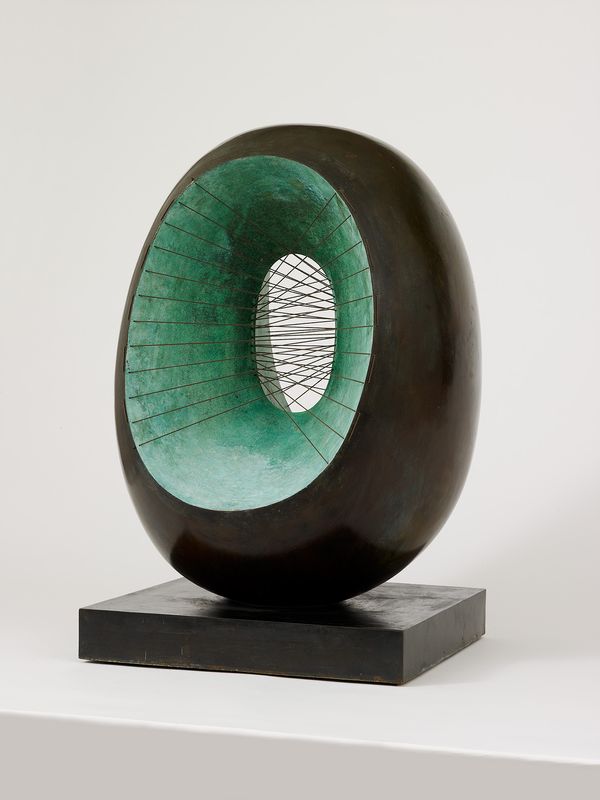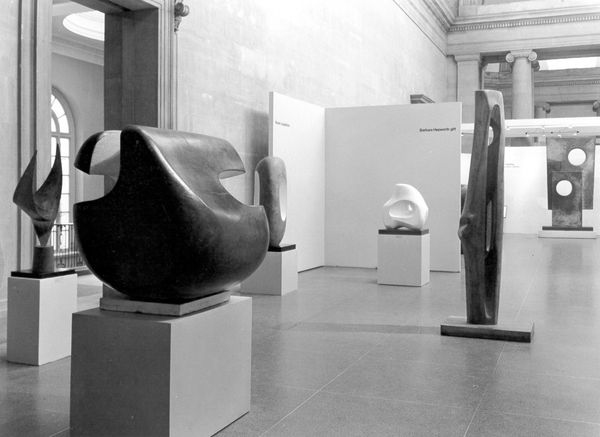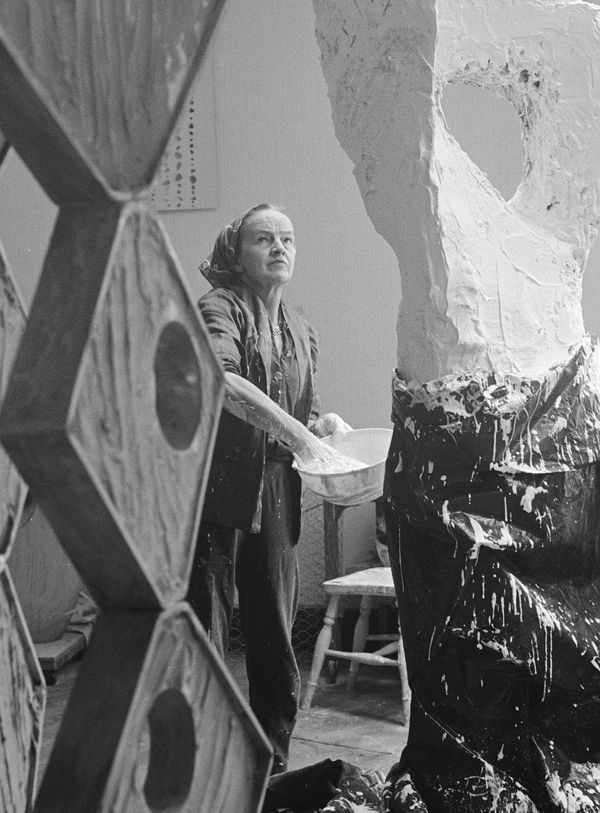Barbara Hepworth at work in her studio, St Ives, 1964.
In 2015, Tate Britain hosted a major exhibition, 'Barbara Hepworth: Sculpture for a Modern World'. Displaying over a hundred sculptures, the show reminded us of the international reputation that Hepworth enjoyed in the 1950s and 60s at the zenith of her career. This retrospective and its broad survey of works traced Hepworth’s sculptural development through the decades, but went no further than 1965. We at Phillips, in partnership with The Hepworth Wakefield, wanted to take a step further and celebrate the final and most productive decade of Dame Barbara’s illustrious career.
It was in 1965 that Hepworth was made a Dame of the British Empire. Internationally fêted and at her career's pinnacle, this was seen as a fitting tribute to an artist whose contribution to British sculpture had made her one of the most influential sculptors of the mid-twentieth century. However, if this honour was intended as a nod to a career already fulfilled, it failed to predict the extraordinary drive and energy with which Hepworth would continue to pursue her craft. Despite being diagnosed with cancer that same year, what followed was a ten-year period that proved to be the most prolific, experimental and varied of her career. It is the body of work from this particular period that fascinates me the most.
I don't think anyone realises how much the last ten years have been a fulfillment of my youth.
— Dame Barbara Hepworth
My own association with the life and works of Barbara Hepworth goes back a long way. As a child, I spent summer holidays with my family in St. Ives Bay, Cornwall, not far from 'Little Park Owles', the house in which Barbara Hepworth and Ben Nicholson lived alongside artist Margaret Mellis (an artist I would come to know well personally) and her writer husband Adrian Stokes for several months in 1939.
My early interest in art can be linked, not only to my art teacher father, but also directly to my regular summer visits to St. Ives. It was here, visiting my Cornish grandfather, that I became immersed in the art of Barbara Hepworth, Ben Nicholson, Christopher Wood and Alfred Wallis. Whilst the opening of Tate St. Ives in 1993 absorbed me more generally in the life and work of these British Modernists, it was the Barbara Hepworth Museum and Sculpture Garden in particular that evoked my earliest St. Ives memories. Taken on by the Tate in 1980, also the year I was born, Hepworth's house, studio and gardens provided many years of close encounters with key works in their natural environment.

Barbara Hepworth, St Ives, England, May 1957.
I was captivated by the monumentality of the sculptures there, beautifully situated in the open-air garden environment for which they had been specifically created. I was equally taken by the workshop, where the remains of her tools, materials and part-worked pieces were left completely untouched. It was here during the period from 1965-1975, when Barbara was at her most prolific, that she would have meticulously and relentlessly chiseled, sculpted and shaped her works. The tools and unfinished sculptures left in the workshop, and still viewable today, convey a narrative of the sculptor’s life and working practice that have remained more or less the same since the 1970s. It was this insight, and glimpse into her working process that helped me to understand the levels of skill, technique and sheer physical endeavour that Hepworth would have needed to undertake in order to realise each of her sculptures.
Hepworth created nearly as many works during the 1960s as in the previous 35 years. To understand the defining characteristics of Hepworth’s sculptures during the final ten years of her career, one has to understand the context and circumstances preceding this prolific period of creativity.
Barbara Hepworth’s career was accelerated by a series of events. She experienced intense international recognition after representing Britain at the Venice Biennale in 1950 and winning the Grand Prix at the Sao Paulo Biennale in 1959. She also enjoyed critical acclaim after Single Form (1964) was commissioned for the United Nations in New York.
These many successes afforded her the freedom to be able to explore new forms of expression, particularly in bronze: "While always remaining constant to my conviction about truth to material...I have found a greater freedom for myself," noted Hepworth in 1961. This 'freedom' also came from Hepworth's flexible approach to revisiting themes and techniques from earlier sculptures, and drawing upon the vast stores of experience and aritst influences that she had accumulated throughout a career that had already spanned four decades.
While always remaining constant to my conviction about truth to material...I have found a greater freedom for myself.
— Dame Barbara Hepworth

Barbara Hepworth Spring, 1965, cast 1966. Bronze with strings. Hepworth Estate, on long loan to The Hepworth Wakefield (Wakefield Permanent Art Collection). Arts Council Collection, Southbank Centre, London © Bowness, Hepworth Estate
It was in the 1930s that Hepworth first came across the stringed sculptures of the Russian constructivist and modernist Naum Gabo. Spring (1965) shows elements of his influence. It was while living with Margaret Mellis and Adrian Stokes in Carbis Bay that Hepworth and Nicholson were joined by their close friend Gabo. In an interview I conducted with Margaret Mellis in 2005 for her exhibition catalogue 'Pandora’s Box' held at the Strand Gallery in Aldeburgh, Suffolk, Mellis described to me how Naum Gabo had a "pervasive effect on everybody, much more than Ben had". Hepworth herself paid homage to his influence in her autobiographical writings from 1952. In it she proclaimed that, "it is impossible to forget the extraordinary beauty of his sculptures"… and that the "exceptional charm of his personality when talking of creative processes seemed to unleash a great energy in all who came near him."
It was this energy that Hepworth would herself channel in a phase of production during her later life that saw her continue to experiment with new materials, including sculptures made in bronze, slate, silver and gold. During this period Hepworth also worked extensively in marble, a material she had been drawn to during the 1920s but had not always been able to afford. However, her international success left her with no shortage of commissions, and it meant that during the 60s and 70s Hepworth could now afford to work freely in this medium.
One must be entirely sensitive to the structure of the material that one is handling. One must yield to it in tiny details of execution, perhaps the handling of the surface or grain, and one must master it as a whole.
— Dame Barbara Hepworth

London, Tate Britain, Barbara Hepworth, 1968 © Tate, London 2016.
As a British sculptor, Hepworth is often described as being second in preeminence in the UK to Henry Moore. This is a notion that I would contest. This perception owed much to the patronage of Herbert Read, one of the most important and prolific art historians in Britain, who, whilst recognising Hepworth's role in the development of his aesthetic philosophy, constantly fêted Moore as the exemplar of artistic Modernism. All notions of an artist's preeminence is subjective, and perhaps my championing of Hepworth comes from my personal connection with St. Ives, her studio and my time spent with Margaret Mellis in recollecting the great artist.
As a British sculptor, Hepworth is often described as being second in preeminence in the UK to Henry Moore. This is a notion that I would contest. This perception owed much to the patronage of Herbert Read, at the time, one of the most important and prolific art historians in Britain, who, whilst recognising Hepworth’s role in the development of his aesthetic philosophy, constantly feted Moore as the exemplar of artistic Modernism. All notions of an artist’s pre-eminence, is subjective, and perhaps my championing of Hepworth comes from my personal connection with St. Ives, her studio, and time spent with Margaret Mellis with her first hand personal recollections of the artist.
Sentimentality to one side, the work that Hepworth produced from her studio in her last decade (1965–75) provides us with a reminder of why some (including myself) question the established viewpoint. I maintain that she deserves parity with Moore. This period saw her work re-energised and showcased her versatility, adaptability, mastery of materials, and a willingness to re-engage with the past, drawing upon this experience, whilst also looking to the future. It is a period of her work that was more varied than that of any other time in her career, and it must not be overlooked.
— Peter Sumner, Senior Director, Head of Contemporary Art, Phillips London
